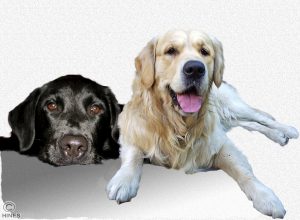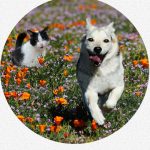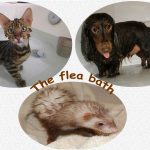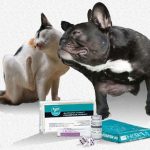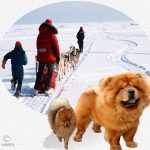Ron Hines DVM PhD
About Your Dog’s Hair
Your dog’s hair grows in a 3-phase cycle. Let’s call the first portion the anagen phase. In the anagen phase, the individual hair does its most rapid growing. Once it has almost reached its full length, it enters a very short catagen phase during which time hair growth slowly ends. Then it enters its telogen or resting phase when no growth occurs at all and during which, as time goes by, shedding occurs. Others, including Wikipedia, describe the phases of hair growth and loss a bit differently. Despite years of research efforts on hair and hair growth, we still do not understand much about the intricacies of the hair growth cycle. In some dogs, the first two parts of the cycle last a very long time (over a year), in high-shedders they are much shorter (a month or so). This determines the rate at which your dog sheds. We used to assume that the hair that you find in the comb was mostly from follicles in the telogen (resting) phase. But we now think that this is the hair that is being replaced as new hair is being formed. So stimulating hair growth in your dog may actually make the problem worse. We do not understand why the hair roots loosens up on your pet at that point. But it is probably not because a new hair is forcing the old one out.
That is why breeds that need frequent haircuts tend to shed less. The most popular of these breeds are poodles, schnauzers, Shih-Tzus, Scotties, Bichons and Airedales, as well as Yorkshire, Cairn, Maltese, Silky, Wheaten, Fox, Bedlington and West Highland terriers. Greyhounds are generally low shedders too. Long-haired dogs may appear to shed more, but this is really just an illusion because their long hair strands are easier to notice. The color of your dog’s hair also influences how noticeable hair is around the house.
If you adopt a mixed breed dog and shedding is important to you, adopt one with a curly or long hair coat or one that you know is a cross with one of the low-shed breeds. The trade off that dogs with this type of hair coat need more grooming and suffer more in hot weather.
At a distant time in the past, dogs entered their shedding cycle in the spring in response to increasing daylight hours just as wolves and other wild animals do. But as they slowly evolved and adjusted to living with us, besides loosing much of their wild nature, they also lost their normal periodic hair coat and reproductive cycles. These cycles once operated under the influence of circadian rhythms. How they work is poorly understood, but they control all annual changes including reproduction, mood and hair growth. We know that the biological timekeeper of rhythm is in some way related to the pineal gland and probably to the hormone, melatonin as well. While your pet’s hair is in its telogen or resting phase, a new hair begins to form below it in the hair follicle. At one time this occurred simultaneously in all the dog’s hair follicles, but when they lost their natural circadian rhythm the follicles no longer shed at the same time. This accounts for year-long shedding in our pets. Many dogs still shed the most in the spring and fall. It is the length of the days and not seasonal temperature change that accounts for this.
Nordic breeds Huskies, Spitz, etc.
These arctic breeds have retained this wild seasonal shed pattern best. They generally do their shedding in one or two short spurts during the year – often in the spring and fall. That predisposes these breeds to a special hair coat problem, Alopecia X.
Is Normal Shedding The Same As Hair Loss?
Hair loss is different than shedding. The only thing the two have in common is that hair is missing. The most common cause of hair loss in dogs and cats is scratching and chewing due to flea infestations or allergies or both. (read here & here) When a dog sheds normally, a new hair is growing it the hair follicle waiting to replace it. When a dog suffers from hair loss due to some form of illness or hormonal imbalance, no new hair grows, or hair growth is slower than it should. In one form of hair loss caused by a sluggish thyroid gland (hypothyroidism), hair is replaced too infrequently and individual hairs stay on the pet so long, that they literally wear out. This is why black coats in dogs with this problem sometimes appear reddish brown. Black cats with a variety of chronic health issues sometimes turn reddish brown as well. But no one has reported that their color change is related to slower hair replacement. Dogs that have hair loss on areas that rub a lot (their sides [flanks], hind legs and tail) sometimes have a slow hair replacement problem as well.
What Steps Can I Take That Might Make My Dog Shed Less?
Your pet’s hair must be replaced on a regular basis for it to retain a natural lustrous coat. Hair wears out. So new hairs in anagen need to be continually produced. The best we can hope for is to synchronize anagen to one or two short periods of the year as occurred in your pet’s wild ancestors.
Light
It appears that the more natural sunlight your dog is exposed to, the more likely it is to shed in one or two discrete periods. This might not be the case in your particular dog – but it is worth a try. Seasonal changes in all animals are due to changes in the length of daylight, not to changes in the weather.
Melatonin
We know that the Nordic breeds, that have retained more of their normal seasonal shedding pattern still shed in response to the melatonin level in their bodies. We do not know if other dog breeds no longer produces enough melatonin in those amounts or if the pet’s hair has lost its ability to respond to melatonin. In certain situations, melatonin administration cures hair loss in Nordic breeds. (read here) The problem is that melatonin levels naturally pulse in the body. So just giving a supplement does not duplicate what naturally occurs. Melatonin supplements for hair loss or shedding have not been studied closely enough for me to recommend any specific dose.
Nutrition
A nutritionally balanced diet minimizes shedding. Be sure the pet food you feed contains adequate levels of protein, fats, vitamins and minerals. Most nationally marketed brands do. But if your pet receives a large portion of it’s diet in table scraps, try cutting down on the amount of leftovers.
Stuff Sold In Stores & Online To Stop Shedding
The body washes, fatty acid and vitamin sprays you can purchase at best moisturize your pet’s skin with the oils they contain. If dry skin is a part of the problem they can be helpful. They do not affect hair shafts, hair growth or help with shedding. I do not believe that these oral coat supplements containing vitamins, fatty acids and other nutrients help the majority of dogs that are already receiving a good diet; but you are welcome to try them.
Omega-3 supplements
We have very little scientific evidence that Omega-3 fatty acid-containing products really reduce shedding either. But some people think they do. They seem to have so many other positive benefits to health that you might wish to give them to your dog.
Frequent Brushing
Brushing your pet frequently with a proper comb will remove the problem of hair around the house. This is the low-tech solution and most dogs enjoy a brushing. I find it best when I use a comb which has its wire teeth embedded in a rubber backing (slicker comb). Many that are sold in big box pet stores have their teeth too widely spaced. There is a proper tooth spacing and length for each different size dog and different type of hair coat. Consult a groomer.
Good General Health
Pets in good general health often shed less than those that are not. Anything that makes your pet scratch will increase the amount of hair you find around the house. As I mentioned, the most common causes are fleas and allergies. A general health blood screening ordered by your veterinarian is always a wise choice.
JAK Inhibitors?
For reasons still unknown, tofacitinib (Xeljanz®) a compound closely related to the oclacitinib (Apoquel®) which is given to dogs to lessen itching, also stimulates hair growth. (read here & here) Both these compounds inhibit certain messenger chemicals (cytokines) through complex pathways. These are powerful drugs with potential negative side effects. I would avoid using them for a hair loss or shedding problem that is causing your pet no pain or discomfort.
You are on the Vetspace animal health website
Visiting the products that you see displayed on this website help pay the cost of keeping these articles on the Internet.

